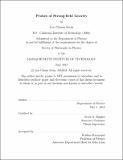| dc.contributor.advisor | Scott A. Hughes. | en_US |
| dc.contributor.author | Stein, Leo Chaim | en_US |
| dc.contributor.other | Massachusetts Institute of Technology. Dept. of Physics. | en_US |
| dc.date.accessioned | 2013-03-01T14:33:53Z | |
| dc.date.available | 2013-03-01T14:33:53Z | |
| dc.date.copyright | 2012 | en_US |
| dc.date.issued | 2012 | en_US |
| dc.identifier.uri | http://hdl.handle.net/1721.1/77256 | |
| dc.description | Thesis (Ph. D.)--Massachusetts Institute of Technology, Dept. of Physics, 2012. | en_US |
| dc.description | This electronic version was submitted by the student author. The certified thesis is available in the Institute Archives and Special Collections. | en_US |
| dc.description | Cataloged from student-submitted PDF version of thesis. | en_US |
| dc.description | Includes bibliographical references (p. 221-234). | en_US |
| dc.description.abstract | In this thesis, I investigate several ways to probe gravity in the strong-field regime. These investigations focus on observables from the gravitational dynamics, i.e. when time derivatives are large: thus I focus on sources of gravitational waves. Extreme mass-ratio inspirals (EMRIs) can be very sensitive probes of strong-field physics. Predicting observables from EMRIs must be done numerically, so accurate numerical methods are required to ensure that any comparison with measurement is not spoiled by numerical artefacts. The first investigation of this thesis is a spectral (in the angular sector), pseudospectral (in the radial sector) time-domain PDE solver for perturbations of a Kerr black hole (i.e. solving the Teukolsky equation). The method exhibits good convergence and prompts much future investigation. A second approach to probing strong gravity is to consider theories which are general relativity (GR) with a few small corrections and investigate the effect of these corrections on observables. Since gravitational waves are the prime observable and they control the long-term evolution of dynamical systems, I investigate their properties in almost-GR theories. The second investigation of this thesis is a study of the propagation and energy content of gravitational waves in these theories. I find that in a large class of theories, approaching the asymptotically at part of spacetime, gravitational waves propagate in the same fashion as in GR and have the same effective stress-energy tensor as in GR. Next, I study the strong-field correction to the structure of a Schwarzschild black hole in a class of theories. Finally, with these ingredients, I investigate the leading corrections to the dynamics and observables of a comparable mass-ratio inspiral using post-Newtonian techniques. The main result is the appearance of dipolar scalar radiation in this class of theories. The dipolar radiation has a frequency dependence which does not arise in GR and is a distinct signature of corrections. Such signatures should be testable using gravitational wave detection and pulsar timing. | en_US |
| dc.description.statementofresponsibility | by Leo Chaim Stein. | en_US |
| dc.format.extent | 234 p. | en_US |
| dc.language.iso | eng | en_US |
| dc.publisher | Massachusetts Institute of Technology | en_US |
| dc.rights | M.I.T. theses are protected by
copyright. They may be viewed from this source for any purpose, but
reproduction or distribution in any format is prohibited without written
permission. See provided URL for inquiries about permission. | en_US |
| dc.rights.uri | http://dspace.mit.edu/handle/1721.1/7582 | en_US |
| dc.subject | Physics. | en_US |
| dc.title | Probes of strong-field gravity | en_US |
| dc.type | Thesis | en_US |
| dc.description.degree | Ph.D. | en_US |
| dc.contributor.department | Massachusetts Institute of Technology. Department of Physics | |
| dc.identifier.oclc | 827335664 | en_US |
